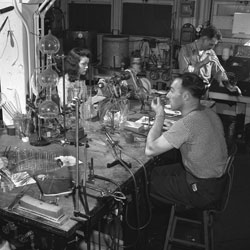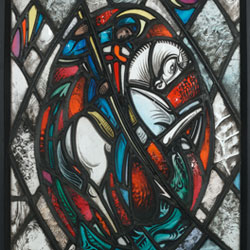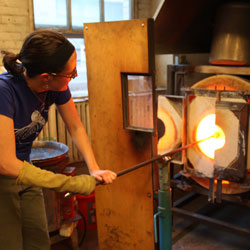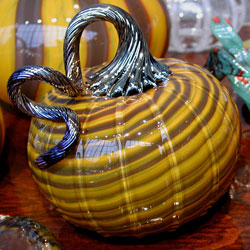
| Vol.
XXIV No.
3 January / February 2012 |
| contents |
| Printable Version |
Glass at MIT: Beauty and Utility
In MIT’s Glass Lab, students gracefully shape glowing, molten glass into works of art, while in an MIT research lab researchers explore the use of nano-sized glass stamps for tiny, precise biosensors to enable clinicians to test for disease.

(click on image to enlarge)
Glass at MIT is ubiquitous. Since MIT’s first classes in 1865, its labs have contained test tubes, retorts, vacuum lines, and vessels of all sizes and shapes essential to scientific work. Learning to blow glass was a standard part of a chemistry student’s education, while architecture students studied its central role in the design and construction of buildings. Glassmaking is nearly 4000 years old, but scientists and artists today, like the alchemists of the past, remain fascinated by the “frozen liquids” that can be manipulated at high temperatures and cooled to rigidity.

A new exhibition by the MIT Libraries takes a historic view, tracing the evolution of glassmaking from the sixteenth to the twentieth century. It features a recent gift to the Libraries: the Charles J. Connick Stained Glass Foundation Collection, as well as rare books from the Institute Archives and Special Collections. Stunning stained glass windows, sketches, full-size drawings, tools, and objects from the Connick collection, the MIT Glass Lab, and the MIT Museum are on display, along with video of artists working in the medium.
(click on image to enlarge)
Glass at MIT: Beauty and Utility opened February 10, 2012 in the Maihaugen Gallery (14N-130) and is on view through July 2012. See libraries.mit.edu/maihaugen for hours and information.
| Back to top | |
| Send your comments |
| home this issue archives editorial board contact us faculty website |

